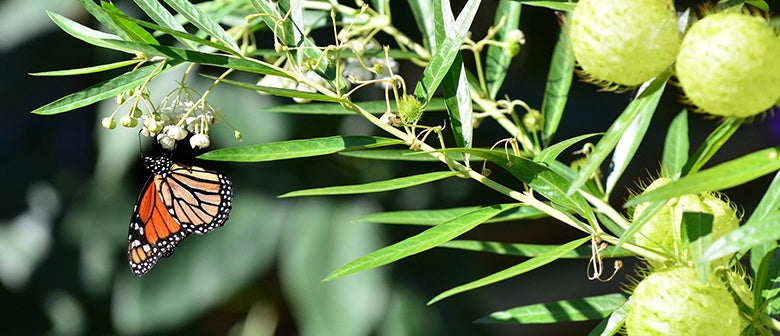Summer is the season of the monarch butterfly, and for children and adults alike it is an amazing sight to see the beautiful monarch butterflies land among the swan plants to lay their eggs. The caterpillars are nearly as cute with their little gold, black and white striped bodies, crawling over plants, and munching their leaves. As well as being fun to watch it’s a great learning experience for children, to be able to see the life cycle of the butterfly from egg to caterpillar, to pupa to butterfly. Find out more information about monarch butterflies here.
 The caterpillar’s main food source is the swan plant which is easily grown by seed in spring, and will take between 14-21 days to germinate. They are relatively quick growing plants but you may need a few to feed all the hungry caterpillars. Many people are surprised with just how much they eat. I often advise to have quite a few plants but keep a couple netted so that butterflies can’t lay eggs on them which will provide more food for later, although it isn’t guaranteed that a butterfly won’t find a way to bypass the net and lay eggs! Another option is to start off with big advanced plants and continue to raise more seeds throughout the season which can last well into autumn.
The caterpillar’s main food source is the swan plant which is easily grown by seed in spring, and will take between 14-21 days to germinate. They are relatively quick growing plants but you may need a few to feed all the hungry caterpillars. Many people are surprised with just how much they eat. I often advise to have quite a few plants but keep a couple netted so that butterflies can’t lay eggs on them which will provide more food for later, although it isn’t guaranteed that a butterfly won’t find a way to bypass the net and lay eggs! Another option is to start off with big advanced plants and continue to raise more seeds throughout the season which can last well into autumn.
The best way to raise seed is in a warm spot inside, in pots or trays with seed raising mix, then transplant them outside when they get to about 10cm high. Alternatively, sow directly in the soil if the weather is warm and all chance of frost is behind us. Feed your plant with a liquid fertilizer to give it a good start.
 Swan plants grow best in full sun in a well-drained position, reaching up to 2 metres. A sheltered spot is best as they do not fare against strong winds and like to keep moist over the summer months. If you plan to continue growing swan plants over Winter you will need to protect them from frost, which is why most treat them as annuals. I like to prune swan plants back after the caterpillars have eaten them and let them re-grow again. When swan plants reach maturity they produce amazing big fluffy seed pods which is another interesting aesthetic, and can be used as an engaging activity for children, to gather the seeds to replant.
Swan plants grow best in full sun in a well-drained position, reaching up to 2 metres. A sheltered spot is best as they do not fare against strong winds and like to keep moist over the summer months. If you plan to continue growing swan plants over Winter you will need to protect them from frost, which is why most treat them as annuals. I like to prune swan plants back after the caterpillars have eaten them and let them re-grow again. When swan plants reach maturity they produce amazing big fluffy seed pods which is another interesting aesthetic, and can be used as an engaging activity for children, to gather the seeds to replant.
Never spray the leaves with fertiliser or with pesticides, even if your plant gets some nasty pests as this will harm the caterpillar’s development. Aphids may have to be removed manually (just squash them with your fingertips) and try planting companion plants close by such as marigolds and chives.
Swan plants are toxic if ingested so care is needed if young children are around. Encourage and educate children to wear gloves if they have to touch the plant for any reason. You could put a cage or a fence around the pots to really safe guard the plant, or keep them in containers so they can be moved out of reach. Encourage children to enjoy the swan plant and butterflies without any internal contact, and if necessary, to wash and sanitize their hands afterwards. If ingestion occurs, contact your doctor for advice.
Once the butterflies have laid their eggs, you might find you have too many caterpillars for the size of the plant – it is amazing just how many leaves they can munch! You may need to pick off eggs in order for there to be enough food. If you find the caterpillars have eaten all the leaves and left only the stem, don’t throw the plant away as it can regrow, just feed the swan plant a liquid fertiliser and let it come back again.
Have fun planting those swan plants and I hope you get as much joy as I do from seeing the amazing monarchs emerge!
You can download a caterpillar colouring in sheet here.











